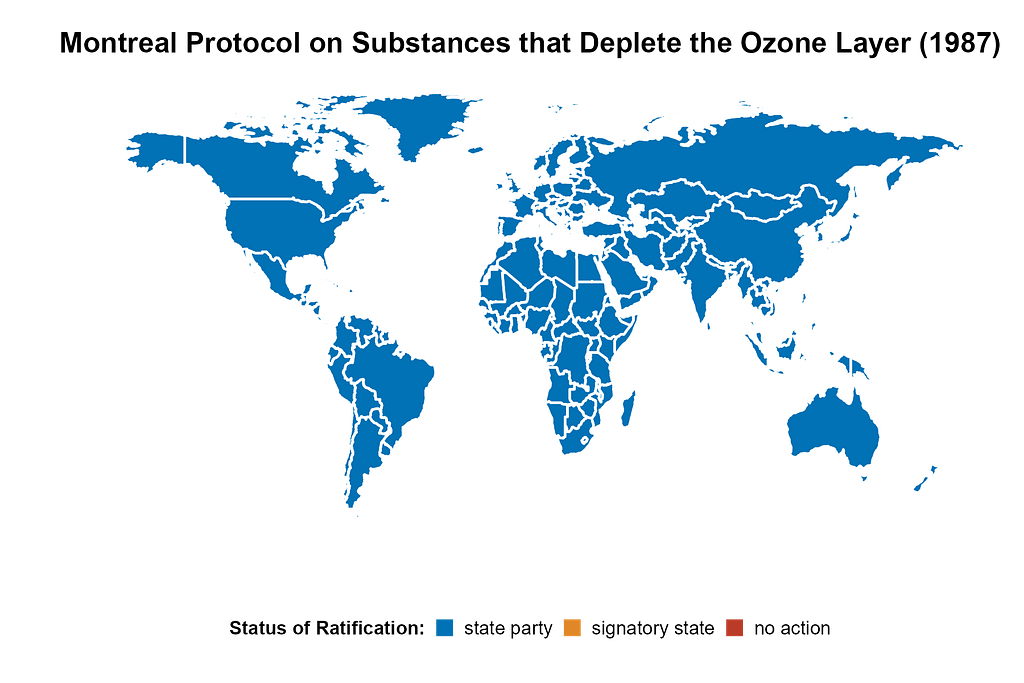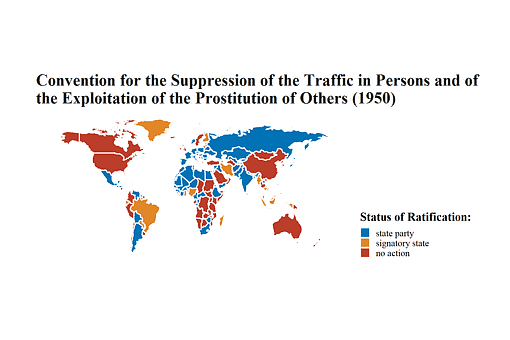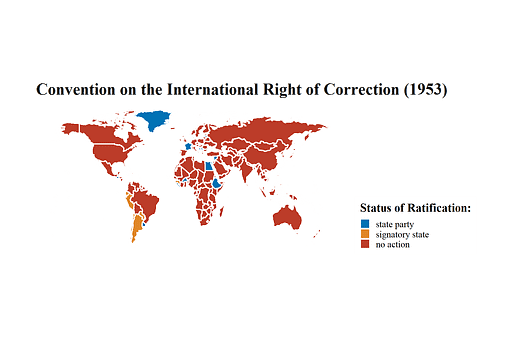Luiza Vaskys Lima & Amelia Tirey
In this post, we explore the current ratification status of the 1he 1987 Montreal Protocol on Substances that Deplete the Ozone Layer. This landmark international environmental legal instrument came into force on January 1, 1989, and most experts believe that it is one of the most successful treaties in modern human history.
The protocol was adopted on September 16, 1987, at the Vienna Convention for the Protection of the Ozone Layer and it entered into force on January 1, 1989. It requires the phasing out of chlorofluorocarbons (CFCs) and other ozone-depleting substances (ODSs). These emissions, present in common household items such as air conditioners and refrigerators, were noted for diminishing the planet’s protective ozone layer, which is responsible for blocking harmful ultraviolet radiation from the sun. By ratifying this treaty, state parties agreed to decrease emissions of these harmful gasses, regulate their sources, and conduct periodic reports of their compliance with the protocol’s provisions.
We collected data on the protocol’s ratification status using information available on the UN Treaty Collection’s website. Using this data we developed the following choropleth map using the ggplot2 package for R.

The map shows that every single UN member has ratified the treaty. This is one of the reasons the Montreal Protocol is considered one of the UN’s foremost accomplishments in environmental protection.
The widespread backing of this legal instrument, unlike other climate agreements, could be attributed to the manageable task of replacing CFCs. Due to readily accessible, affordable alternatives, both public and private industrial sectors did not oppose this agreement.
While the Montreal Protocol is celebrated for its collaborative success, it’s important to maintain a balanced perspective regarding its impact on the current climate crisis and the continuous imperative for international action. Although the treaty made significant strides in curbing CFC emissions, the treaty alone falls short of being a comprehensive solution to climate change. Furthermore, it is essential to acknowledge that substitutes for CFCs, such as HFCS and HCFCS, possess significant heat-trapping properties and contribute to global warming, adding complexity to the issue.
However, the protocol’s significance should not be underestimated. It showcases how the United Nations membership can come together to confront a shared challenge. At a time when the international community is searching for ways to address climate change, the Montreal Protocol should inspire a collective effort to replicate its success by seeking consensus-driven solutions.
Want to learn more about this legal instrument?
Data on this convention’s ratification status is available on the World Politics Data Lab’s GitHub page. The most recent dataset was uploaded to the repository on October 1, 2023.
For more information on the convention’s history and for its current application, please refer to the following academic writings:
Gonzalez, M., Taddonio, K.N. & Sherman, N. (2015). “The Montreal Protocol: how today’s successes offer a pathway to the future,” Journal of Environmental Studies and Sciences 5(2): 122–129.
Green, B. (2009), “Lessons from the Montreal Protocol: Guidance for the next International Climate Change Agreement,” Environmental Law 39(1): 253-283.
About the authors:
Luiza Vaskys Lima is a junior, majoring in International Relations and Philosophy, with a minor in Environmental Studies and Sustainability.
Amelia Tirey is a junior, majoring in History with a minor in Political Science.
Editor’s note: This post is part of a long-term project. Students enrolled in Drew University’s Semester on the United Nations, Principles in International Law, and International Human Rights have been and will be collecting data on the ratification status of treaties deposited in the United Nations Treaty Collection. For more information on this project and its learning goals, click here.


